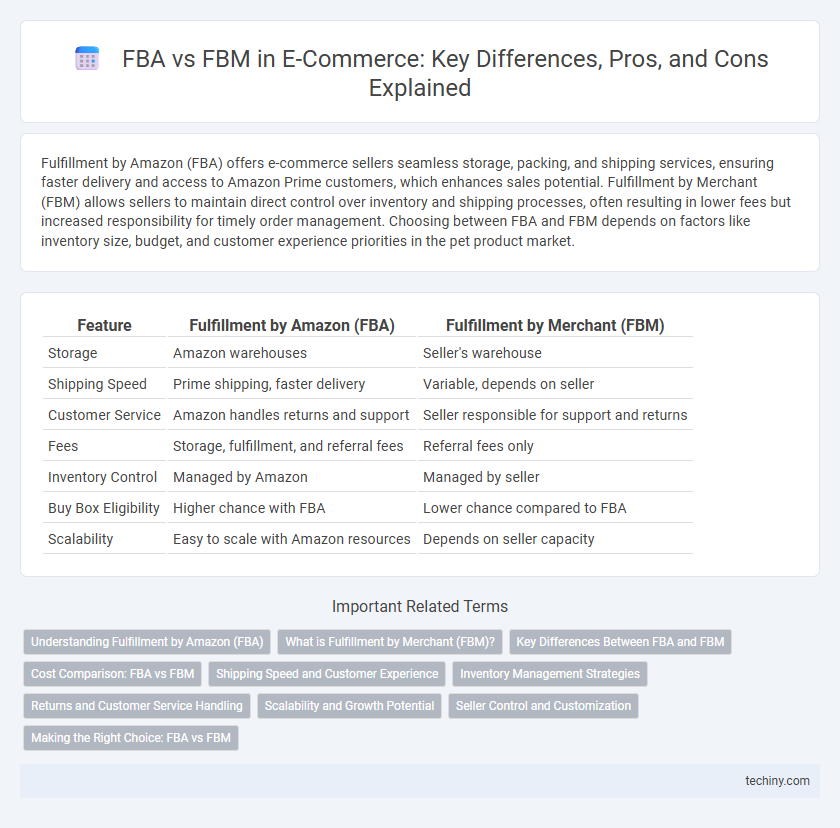Fulfillment by Amazon (FBA) offers e-commerce sellers seamless storage, packing, and shipping services, ensuring faster delivery and access to Amazon Prime customers, which enhances sales potential. Fulfillment by Merchant (FBM) allows sellers to maintain direct control over inventory and shipping processes, often resulting in lower fees but increased responsibility for timely order management. Choosing between FBA and FBM depends on factors like inventory size, budget, and customer experience priorities in the pet product market.
Table of Comparison
| Feature | Fulfillment by Amazon (FBA) | Fulfillment by Merchant (FBM) |
|---|---|---|
| Storage | Amazon warehouses | Seller's warehouse |
| Shipping Speed | Prime shipping, faster delivery | Variable, depends on seller |
| Customer Service | Amazon handles returns and support | Seller responsible for support and returns |
| Fees | Storage, fulfillment, and referral fees | Referral fees only |
| Inventory Control | Managed by Amazon | Managed by seller |
| Buy Box Eligibility | Higher chance with FBA | Lower chance compared to FBA |
| Scalability | Easy to scale with Amazon resources | Depends on seller capacity |
Understanding Fulfillment by Amazon (FBA)
Fulfillment by Amazon (FBA) allows sellers to store products in Amazon's fulfillment centers, where Amazon handles storage, packaging, and shipping, ensuring fast delivery and Prime eligibility. FBA helps businesses scale by leveraging Amazon's vast logistics network, reducing shipping errors and customer service burdens. This service boosts product visibility and customer trust through Amazon's reliable fulfillment standards and return processing.
What is Fulfillment by Merchant (FBM)?
Fulfillment by Merchant (FBM) is an e-commerce fulfillment method where sellers handle storage, packaging, and shipping of products directly to customers. This approach allows merchants to maintain greater control over inventory management and shipping processes without relying on Amazon's fulfillment centers. FBM is ideal for sellers who prefer customized packaging or have niche products that don't require Amazon's vast logistics network.
Key Differences Between FBA and FBM
Fulfillment by Amazon (FBA) leverages Amazon's extensive logistics network for storage, packaging, and shipping, ensuring Prime eligibility and faster delivery times, which can significantly enhance customer trust and sales volumes. Fulfillment by Merchant (FBM) requires sellers to handle inventory storage, order processing, and shipping independently, providing more control over inventory but potentially resulting in longer delivery times and higher operational complexity. FBA incurs higher fees due to Amazon's services, while FBM offers lower costs but demands more seller involvement in fulfillment processes and customer service management.
Cost Comparison: FBA vs FBM
Fulfillment by Amazon (FBA) incurs higher upfront costs, including storage fees, fulfillment fees, and Amazon's commission, which can significantly impact profit margins for sellers with low volume or heavy products. Fulfillment by Merchant (FBM) offers lower fees by allowing sellers to handle storage and shipping independently, though it demands more resources and may increase shipping costs. Sellers must weigh FBA's streamlined logistics and Prime eligibility against FBM's potentially lower costs and greater control over inventory.
Shipping Speed and Customer Experience
Fulfillment by Amazon (FBA) typically offers faster shipping speeds through Amazon's extensive logistics network, enabling Prime eligibility and two-day delivery, which significantly enhances customer satisfaction. Fulfillment by Merchant (FBM) shipping times vary widely depending on the seller's infrastructure, often resulting in longer delivery periods and less predictable customer experiences. Efficient shipping speed directly correlates with higher positive customer reviews and repeat purchases in e-commerce businesses.
Inventory Management Strategies
Fulfillment by Amazon (FBA) enables sellers to leverage Amazon's extensive warehousing network, offering streamlined inventory storage, automatic order processing, and faster shipping, which enhances customer satisfaction and scalability. Fulfillment by Merchant (FBM) demands sellers manage their own inventory and shipping logistics, providing greater control over stock levels and customization but requiring robust inventory tracking systems to avoid stockouts or delays. Effective inventory management strategies for FBA focus on maintaining replenishment cycles aligned with Amazon's performance metrics, while FBM sellers prioritize real-time inventory updates and flexible supply chain coordination.
Returns and Customer Service Handling
Fulfillment by Amazon (FBA) provides streamlined returns processing and customer service, leveraging Amazon's extensive support infrastructure to handle refunds, exchanges, and inquiries promptly, enhancing customer satisfaction. Fulfillment by Merchant (FBM) requires sellers to manage all returns and customer service interactions independently, which can increase response times and operational complexity but allows for greater control over the return policies. Efficient returns management and customer service quality significantly impact seller ratings and overall e-commerce performance on the Amazon marketplace.
Scalability and Growth Potential
Fulfillment by Amazon (FBA) offers greater scalability and growth potential by leveraging Amazon's extensive logistics network, enabling sellers to handle increased order volumes efficiently without investing in warehousing or shipping infrastructure. In contrast, Fulfillment by Merchant (FBM) requires sellers to manage their own inventory and shipping, which can limit scalability and slow growth as order volume rises. FBA's seamless integration with Amazon Prime and global marketplaces further accelerates sales growth and expands customer reach.
Seller Control and Customization
Fulfillment by Merchant (FBM) offers sellers greater control over inventory management, packaging, and shipping processes, allowing for tailored customer experiences and branding opportunities. Fulfillment by Amazon (FBA) limits customization due to standardized packaging and shipping protocols but provides access to Amazon's vast logistics network and Prime eligibility. Sellers prioritizing brand control and unique customer engagement often prefer FBM, while those seeking scalable fulfillment and faster delivery favor FBA.
Making the Right Choice: FBA vs FBM
Choosing between Fulfillment by Amazon (FBA) and Fulfillment by Merchant (FBM) hinges on factors such as control over inventory, shipping speed, and cost efficiency. FBA offers benefits like Prime eligibility and Amazon-handled logistics, boosting sales potential and customer trust, while FBM provides sellers with complete control over storage and fulfillment processes, potentially reducing fees and enabling personalized shipping. Analyzing product type, volume, and business scale helps sellers optimize their fulfillment strategy for maximum profitability and customer satisfaction.
Fulfillment by Amazon (FBA) vs Fulfillment by Merchant (FBM) Infographic

 techiny.com
techiny.com